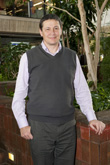DZero physicist wins prestigious UK prize
 |
Guennadi Borissov
Photo: Cindy Arnold |
Physicist Guennadi Borissov has received the annual award in the Division of Nuclear and Particle Physics from the Institute of Physics. Borissov, from Lancaster University in England, was recognized by the UK society for his work on B physics – the study of the intriguing bottom quark and its counterpart, the antiquark.
“I was surprised because this is a very prestigious and very desirable award,” Borissov said. “We’re a small group of very dedicated and very hardworking people. It’s a sign of recognition of DZero and its role in particle physics, in particular in B physics studies.”
In 2006, Borissov was among the principal researchers on a seminal paper published by the DZero collaboration, addressing the frequency with which the Bs meson can flip back and forth, or oscillate, between a particle and an antiparticle. He was also part of a team whose work received media attention, including a front page article in the New York Times, in May of 2010 when DZero found evidence of a bias toward matter over antimatter. This observation, called dimuon charge asymmetry, could help to explain why the universe as we know it is composed of matter.
“This is interesting to the public because it could really reveal the origin of the universe,” Borissov said. “The Standard Model is not able to explain why we have the world around us.”
Because the bottom quark is so heavy and takes a long time to decay, it is a favorite research subject. It is relatively easy for scientists to observe it being affected by phenomena that fall outside the Standard Model.
“Guennadi has made a number of key contributions, not just to physics but to developing tools that enable many people to do physics,” said DZero physicist Peter Ratoff, also from Lancaster University, who nominated Borissov for the prize.
One of these contributions included the development of sophisticated software for tracking B particles after they are produced in collisions. These tools allowed the researchers to exploit the specific capabilities of the DZero experiment.
“Guennadi is a brilliant physicist and an outstanding researcher,” said Stefan Söldner-Rembold, DZero spokesperson.
Borissov will receive the £500 prize at the IOP conference in April.
-Sara Reardon |